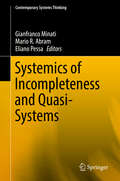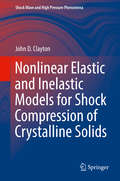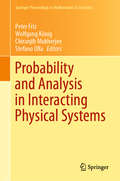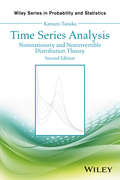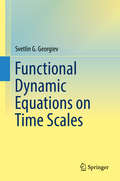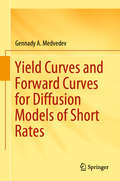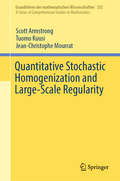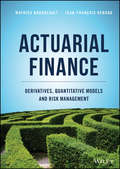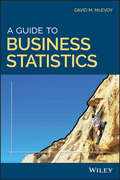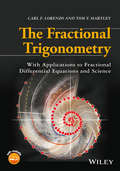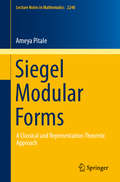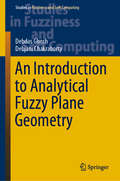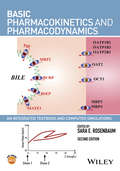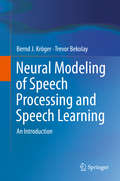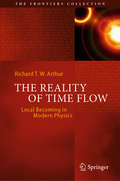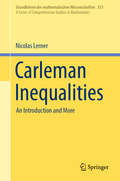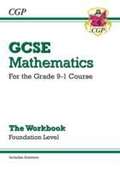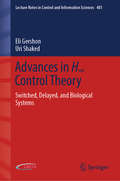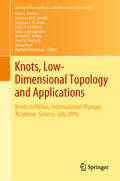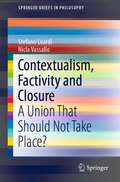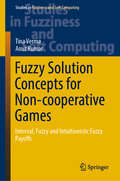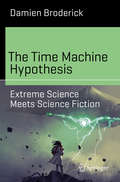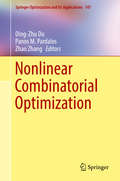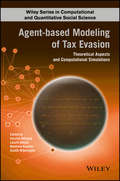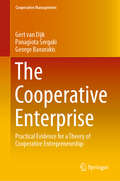- Table View
- List View
Systemics of Incompleteness and Quasi-Systems (Contemporary Systems Thinking)
by Gianfranco Minati Mario R. Abram Eliano PessaThis book contains the proceedings of the Seventh National Conference of the Italian Systems Society. The title, Systemics of Incompleteness and Quasi-Systems, aims to underline the need for Systemics and Systems Science to deal with the concepts of incompleteness and quasiness. Classical models of Systemics are intended to represent comprehensive aspects of phenomena and processes. They consider the phenomena in their temporal and spatial completeness. In these cases, possible incompleteness in the modelling is assumed to have a provisional or practical nature, which is still under study, and because there is no theoretical reason why the modelling cannot be complete. In principle, this is a matter of non-complex phenomena, to be considered using the concepts of the First Systemics. When dealing with emergence, there are phenomena which must be modelled by systems having multiple models, depending on the aspects being taken into consideration. Here, incompleteness in the modelling is intrinsic, theoretically relating changes in properties, structures, and status of system. Rather than consider the same system parametrically changing over time, we consider sequences of systems coherently. We consider contexts and processes for which modelling is incomplete, being related to only some properties, as well as those for which such modelling is theoretically incomplete—as in the case of processes of emergence and for approaches considered by the Second Systemics. In this regard, we consider here the generic concept of quasi explicating such incompleteness. The concept of quasi is used in various disciplines including quasi-crystals, quasi-particles, quasi-electric fields, and quasi-periodicity. In general, the concept of quasiness for systems concerns their continuous structural changes which are always meta-stable, waiting for events to collapse over other configurations and possible forms of stability; whose equivalence depends on the type of phenomenon under study. Interest in the concept of quasiness is not related to its meaning of rough approximation, but because it indicates an incompleteness which is structurally sufficient to accommodate processes of emergence and sustain coherence or generate new, equivalent or non-equivalent, levels. The conference was devoted to identifying, discussing and understanding possible interrelationships of theoretical disciplinary improvements, recognised as having prospective fundamental roles for a new Quasi-Systemics. The latter should be able to deal with problems related to complexity in more general and realistic ways, when a system is not always a system and not always the same system. In this context, the inter-disciplinarity should consist, for instance, of a constructionist, incomplete, non-ideological, multiple, contradiction-tolerant, Systemics, always in progress, and in its turn, emergent.
Nonlinear Elastic and Inelastic Models for Shock Compression of Crystalline Solids (Shock Wave and High Pressure Phenomena)
by John D. ClaytonThis book describes thermoelastic and inelastic deformation processes in crystalline solids undergoing loading by shock compression. Constitutive models with a basis in geometrically nonlinear continuum mechanics supply these descriptions. Large deformations such as finite strains and rotations, are addressed. The book covers dominant mechanisms of nonlinear thermoelasticity, dislocation plasticity, deformation twinning, fracture, flow, and other structure changes. Rigorous derivations of theoretical results are provided, with approximately 1300 numbered equations and an extensive bibliography of over 500 historical and modern references spanning from the 1920s to the present day. Case studies contain property data, as well as analytical, and numerical solutions to shock compression problems for different materials. Such materials are metals, ceramics, and minerals, single crystalline and polycrystalline.The intended audience of this book is practicing scientists (physicists, engineers, materials scientists, and applied mathematicians) involved in advanced research on shock compression of solid materials.
Probability and Analysis in Interacting Physical Systems: In Honor of S.R.S. Varadhan, Berlin, August, 2016 (Springer Proceedings in Mathematics & Statistics #283)
by Wolfgang König Stefano Olla Peter Friz Chiranjib MukherjeeThis Festschrift on the occasion of the 75th birthday of S.R.S. Varadhan, one of the most influential researchers in probability of the last fifty years, grew out of a workshop held at the Technical University of Berlin, 15–19 August, 2016. This volume contains ten research articles authored by several of Varadhan's former PhD students or close collaborators. The topics of the contributions are more or less closely linked with some of Varadhan's deepest interests over the decades: large deviations, Markov processes, interacting particle systems, motions in random media and homogenization, reaction-diffusion equations, and directed last-passage percolation. The articles present original research on some of the most discussed current questions at the boundary between analysis and probability, with an impact on understanding phenomena in physics. This collection will be of great value to researchers with an interest in models of probability-based statistical mechanics.
Time Series Analysis: Nonstationary and Noninvertible Distribution Theory (Wiley Series in Probability and Statistics #4)
by Katsuto TanakaReflects the developments and new directions in the field since the publication of the first successful edition and contains a complete set of problems and solutions This revised and expanded edition reflects the developments and new directions in the field since the publication of the first edition. In particular, sections on nonstationary panel data analysis and a discussion on the distinction between deterministic and stochastic trends have been added. Three new chapters on long-memory discrete-time and continuous-time processes have also been created, whereas some chapters have been merged and some sections deleted. The first eleven chapters of the first edition have been compressed into ten chapters, with a chapter on nonstationary panel added and located under Part I: Analysis of Non-fractional Time Series. Chapters 12 to 14 have been newly written under Part II: Analysis of Fractional Time Series. Chapter 12 discusses the basic theory of long-memory processes by introducing ARFIMA models and the fractional Brownian motion (fBm). Chapter 13 is concerned with the computation of distributions of quadratic functionals of the fBm and its ratio. Next, Chapter 14 introduces the fractional Ornstein–Uhlenbeck process, on which the statistical inference is discussed. Finally, Chapter 15 gives a complete set of solutions to problems posed at the end of most sections. This new edition features: • Sections to discuss nonstationary panel data analysis, the problem of differentiating between deterministic and stochastic trends, and nonstationary processes of local deviations from a unit root • Consideration of the maximum likelihood estimator of the drift parameter, as well as asymptotics as the sampling span increases • Discussions on not only nonstationary but also noninvertible time series from a theoretical viewpoint • New topics such as the computation of limiting local powers of panel unit root tests, the derivation of the fractional unit root distribution, and unit root tests under the fBm error Time Series Analysis: Nonstationary and Noninvertible Distribution Theory, Second Edition, is a reference for graduate students in econometrics or time series analysis. Katsuto Tanaka, PhD, is a professor in the Faculty of Economics at Gakushuin University and was previously a professor at Hitotsubashi University. He is a recipient of the Tjalling C. Koopmans Econometric Theory Prize (1996), the Japan Statistical Society Prize (1998), and the Econometric Theory Award (1999). Aside from the first edition of Time Series Analysis (Wiley, 1996), Dr. Tanaka had published five econometrics and statistics books in Japanese.
Functional Dynamic Equations on Time Scales
by Svetlin G. GeorgievThis book is devoted to the qualitative theory of functional dynamic equations on time scales, providing an overview of recent developments in the field as well as a foundation to time scales, dynamic systems, and functional dynamic equations. It discusses functional dynamic equations in relation to mathematical physics applications and problems, providing useful tools for investigation for oscillations and nonoscillations of the solutions of functional dynamic equations on time scales. Practice problems are presented throughout the book for use as a graduate-level textbook and as a reference book for specialists of several disciplines, such as mathematics, physics, engineering, and biology.
Yield Curves and Forward Curves for Diffusion Models of Short Rates
by Gennady A. MedvedevThis book is dedicated to the study of the term structures of the yields of zero-coupon bonds. The methods it describes differ from those usually found in the literature in that the time variable is not the term to maturity but the interest rate duration, or another convenient non-linear transformation of terms. This makes it possible to consider yield curves not only for a limited interval of term values, but also for the entire positive semiaxis of terms. The main focus is the comparative analysis of yield curves and forward curves and the analytical study of their features. Generalizations of yield term structures are studied where the dimension of the state space of the financial market is increased. In cases where the analytical approach is too cumbersome, or impossible, numerical techniques are used. This book will be of interest to financial analysts, financial market researchers, graduate students and PhD students.
Quantitative Stochastic Homogenization and Large-Scale Regularity (Grundlehren der mathematischen Wissenschaften #352)
by Scott Armstrong Tuomo Kuusi Jean-Christophe MourratThe focus of this book is the large-scale statistical behavior of solutions of divergence-form elliptic equations with random coefficients, which is closely related to the long-time asymptotics of reversible diffusions in random media and other basic models of statistical physics. Of particular interest is the quantification of the rate at which solutions converge to those of the limiting, homogenized equation in the regime of large scale separation, and the description of their fluctuations around this limit. This self-contained presentation gives a complete account of the essential ideas and fundamental results of this new theory of quantitative stochastic homogenization, including the latest research on the topic, and is supplemented with many new results. The book serves as an introduction to the subject for advanced graduate students and researchers working in partial differential equations, statistical physics, probability and related fields, as well as a comprehensive reference for experts in homogenization. Being the first text concerned primarily with stochastic (as opposed to periodic) homogenization and which focuses on quantitative results, its perspective and approach are entirely different from other books in the literature.
Actuarial Finance: Derivatives, Quantitative Models and Risk Management
by Mathieu Boudreault Jean-François RenaudA new textbook offering a comprehensive introduction to models and techniques for the emerging field of actuarial Finance Drs. Boudreault and Renaud answer the need for a clear, application-oriented guide to the growing field of actuarial finance with this volume, which focuses on the mathematical models and techniques used in actuarial finance for the pricing and hedging of actuarial liabilities exposed to financial markets and other contingencies. With roots in modern financial mathematics, actuarial finance presents unique challenges due to the long-term nature of insurance liabilities, the presence of mortality or other contingencies and the structure and regulations of the insurance and pension markets. Motivated, designed and written for and by actuaries, this book puts actuarial applications at the forefront in addition to balancing mathematics and finance at an adequate level to actuarial undergraduates. While the classical theory of financial mathematics is discussed, the authors provide a thorough grounding in such crucial topics as recognizing embedded options in actuarial liabilities, adequately quantifying and pricing liabilities, and using derivatives and other assets to manage actuarial and financial risks. Actuarial applications are emphasized and illustrated with about 300 examples and 200 exercises. The book also comprises end-of-chapter point-form summaries to help the reader review the most important concepts. Additional topics and features include: Compares pricing in insurance and financial markets Discusses event-triggered derivatives such as weather, catastrophe and longevity derivatives and how they can be used for risk management; Introduces equity-linked insurance and annuities (EIAs, VAs), relates them to common derivatives and how to manage mortality for these products Introduces pricing and replication in incomplete markets and analyze the impact of market incompleteness on insurance and risk management; Presents immunization techniques alongside Greeks-based hedging; Covers in detail how to delta-gamma/rho/vega hedge a liability and how to rebalance periodically a hedging portfolio. This text will prove itself a firm foundation for undergraduate courses in financial mathematics or economics, actuarial mathematics or derivative markets. It is also highly applicable to current and future actuaries preparing for the exams or actuary professionals looking for a valuable addition to their reference shelf. As of 2019, the book covers significant parts of the Society of Actuaries’ Exams FM, IFM and QFI Core, and the Casualty Actuarial Society’s Exams 2 and 3F. It is assumed the reader has basic skills in calculus (differentiation and integration of functions), probability (at the level of the Society of Actuaries’ Exam P), interest theory (time value of money) and, ideally, a basic understanding of elementary stochastic processes such as random walks.
A Guide to Business Statistics
by David M. McEvoyAn accessible text that explains fundamental concepts in business statistics that are often obscured by formulae and mathematical notation A Guide to Business Statistics offers a practical approach to statistics that covers the fundamental concepts in business and economics. The book maintains the level of rigor of a more conventional textbook in business statistics but uses a more streamlined and intuitive approach. In short, A Guide to Business Statistics provides clarity to the typical statistics textbook cluttered with notation and formulae. The author—an expert in the field—offers concise and straightforward explanations to the core principles and techniques in business statistics. The concepts are introduced through examples, and the text is designed to be accessible to readers with a variety of backgrounds. To enhance learning, most of the mathematical formulae and notation appears in technical appendices at the end of each chapter. This important resource: Offers a comprehensive guide to understanding business statistics targeting business and economics students and professionals Introduces the concepts and techniques through concise and intuitive examples Focuses on understanding by moving distracting formulae and mathematical notation to appendices Offers intuition, insights, humor, and practical advice for students of business statistics Features coverage of sampling techniques, descriptive statistics, probability, sampling distributions, confidence intervals, hypothesis tests, and regression Written for undergraduate business students, business and economics majors, teachers, and practitioners, A Guide to Business Statistics offers an accessible guide to the key concepts and fundamental principles in statistics.
The Fractional Trigonometry: With Applications to Fractional Differential Equations and Science
by Carl F. Lorenzo Tom T. HartleyAddresses the rapidly growing field of fractional calculus and provides simplified solutions for linear commensurate-order fractional differential equations The Fractional Trigonometry: With Applications to Fractional Differential Equations and Science is the result of the authors’ work in fractional calculus, and more particularly, in functions for the solutions of fractional differential equations, which is fostered in the behavior of generalized exponential functions. The authors discuss how fractional trigonometry plays a role analogous to the classical trigonometry for the fractional calculus by providing solutions to linear fractional differential equations. The book begins with an introductory chapter that offers insight into the fundamentals of fractional calculus, and topical coverage is then organized in two main parts. Part One develops the definitions and theories of fractional exponentials and fractional trigonometry. Part Two provides insight into various areas of potential application within the sciences. The fractional exponential function via the fundamental fractional differential equation, the generalized exponential function, and R-function relationships are discussed in addition to the fractional hyperboletry, the R1-fractional trigonometry, the R2-fractional trigonometry, and the R3-trigonometric functions. The Fractional Trigonometry: With Applications to Fractional Differential Equations and Science also: Presents fractional trigonometry as a tool for scientists and engineers and discusses how to apply fractional-order methods to the current toolbox of mathematical modelers Employs a mathematically clear presentation in an e ort to make the topic broadly accessible Includes solutions to linear fractional differential equations and generously features graphical forms of functions to help readers visualize the presented concepts Provides effective and efficient methods to describe complex structures The Fractional Trigonometry: With Applications to Fractional Differential Equations and Science is an ideal reference for academic researchers, research engineers, research scientists, mathematicians, physicists, biologists, and chemists who need to apply new fractional calculus methods to a variety of disciplines. The book is also appropriate as a textbook for graduate- and PhD-level courses in fractional calculus. Carl F. Lorenzo is Distinguished Research Associate at the NASA Glenn Research Center in Cleveland, Ohio. His past positions include chief engineer of the Instrumentation and Controls Division and chief of the Advanced Controls Technology and Systems Dynamics branches at NASA. He is internationally recognized for his work in the development and application of the fractional calculus and fractional trigonometry. Tom T. Hartley, PhD, is Emeritus Professor in the Department of Electrical and Computer Engineering at The University of Akron. Dr Hartley is a recognized expert in fractional-order systems, and together with Carl Lorenzo, has solved fundamental problems in the area including Riemann’s complementary-function initialization function problem. He received his PhD in Electrical Engineering from Vanderbilt University.
Siegel Modular Forms: A Classical and Representation-Theoretic Approach (Lecture Notes in Mathematics #2240)
by Ameya PitaleThis monograph introduces two approaches to studying Siegel modular forms: the classical approach as holomorphic functions on the Siegel upper half space, and the approach via representation theory on the symplectic group. By illustrating the interconnections shared by the two, this book fills an important gap in the existing literature on modular forms. It begins by establishing the basics of the classical theory of Siegel modular forms, and then details more advanced topics. After this, much of the basic local representation theory is presented. Exercises are featured heavily throughout the volume, the solutions of which are helpfully provided in an appendix. Other topics considered include Hecke theory, Fourier coefficients, cuspidal automorphic representations, Bessel models, and integral representation.Graduate students and young researchers will find this volume particularly useful. It will also appeal to researchers in the area as a reference volume. Some knowledge of GL(2) theory is recommended, but there are a number of appendices included if the reader is not already familiar.
An Introduction to Analytical Fuzzy Plane Geometry (Studies in Fuzziness and Soft Computing #381)
by Debdas Ghosh Debjani ChakrabortyThis book offers a rigorous mathematical analysis of fuzzy geometrical ideas. It demonstrates the use of fuzzy points for interpreting an imprecise location and for representing an imprecise line by a fuzzy line. Further, it shows that a fuzzy circle can be used to represent a circle when its description is not known precisely, and that fuzzy conic sections can be used to describe imprecise conic sections. Moreover, it discusses fundamental notions on fuzzy geometry, including the concepts of fuzzy line segment and fuzzy distance, as well as key fuzzy operations, and includes several diagrams and numerical illustrations to make the topic more understandable. The book fills an important gap in the literature, providing the first comprehensive reference guide on the fuzzy mathematics of imprecise image subsets and imprecise geometrical objects. Mainly intended for researchers active in fuzzy optimization, it also includes chapters relevant for those working on fuzzy image processing and pattern recognition. Furthermore, it is a valuable resource for beginners interested in basic operations on fuzzy numbers, and can be used in university courses on fuzzy geometry, dealing with imprecise locations, imprecise lines, imprecise circles, and imprecise conic sections.
Basic Pharmacokinetics and Pharmacodynamics: An Integrated Textbook and Computer Simulations
by Sara E. RosenbaumUpdated with new chapters and topics, this book provides a comprehensive description of all essential topics in contemporary pharmacokinetics and pharmacodynamics. It also features interactive computer simulations for students to experiment and observe PK/PD models in action.• Presents the essentials of pharmacokinetics and pharmacodynamics in a clear and progressive manner• Helps students better appreciate important concepts and gain a greater understanding of the mechanism of action of drugs by reinforcing practical applications in both the book and the computer modules• Features interactive computer simulations, available online through a companion website at: https://web.uri.edu/pharmacy/research/rosenbaum/sims/• Adds new chapters on physiologically based pharmacokinetic models, predicting drug-drug interactions, and pharmacogenetics while also strengthening original chapters to better prepare students for more advanced applications• Reviews of the 1st edition: “This is an ideal textbook for those starting out … and also for use as a reference book …." (International Society for the Study of Xenobiotics) and “I could recommend Rosenbaum’s book for pharmacology students because it is written from a perspective of drug action . . . Overall, this is a well-written introduction to PK/PD …. “ (British Toxicology Society Newsletter)
Neural Modeling of Speech Processing and Speech Learning: An Introduction
by Bernd J. Kröger Trevor BekolayThis book explores the processes of spoken language production and perception from a neurobiological perspective. After presenting the basics of speech processing and speech acquisition, a neurobiologically-inspired and computer-implemented neural model is described, which simulates the neural processes of speech processing and speech acquisition. This book is an introduction to the field and aimed at students and scientists in neuroscience, computer science, medicine, psychology and linguistics.
The Reality of Time Flow: Local Becoming in Modern Physics (The Frontiers Collection)
by Richard T. ArthurIt is commonly held that there is no place for the 'now’ in physics, and also that the passing of time is something subjective, having to do with the way reality is experienced but not with the way reality is. Indeed, the majority of modern theoretical physicists and philosophers of physics contend that the passing of time is incompatible with modern physical theory, and excluded in a fundamental description of physical reality. This book provides a forceful rebuttal of such claims. In successive chapters the author explains the historical precedents of the modern opposition to time flow, giving careful expositions of matters relevant to becoming in classical physics, the special and general theories of relativity, and quantum theory, without presupposing prior expertise in these subjects. Analysing the arguments of thinkers ranging from Aristotle, Russell, and Bergson to the proponents of quantum gravity, he contends that the passage of time, understood as a local becoming of events out of those in their past at varying rates, is not only compatible with the theories of modern physics, but implicit in them.
Carleman Inequalities: An Introduction and More (Grundlehren der mathematischen Wissenschaften #353)
by Nicolas LernerOver the past 25 years, Carleman estimates have become an essential tool in several areas related to partial differential equations such as control theory, inverse problems, or fluid mechanics. This book provides a detailed exposition of the basic techniques of Carleman Inequalities, driven by applications to various questions of unique continuation.Beginning with an elementary introduction to the topic, including examples accessible to readers without prior knowledge of advanced mathematics, the book's first five chapters contain a thorough exposition of the most classical results, such as Calderón's and Hörmander's theorems. Later chapters explore a selection of results of the last four decades around the themes of continuation for elliptic equations, with the Jerison-Kenig estimates for strong unique continuation, counterexamples to Cauchy uniqueness of Cohen and Alinhac & Baouendi, operators with partially analytic coefficients with intermediate results between Holmgren's and Hörmander's uniqueness theorems, Wolff's modification of Carleman's method, conditional pseudo-convexity, and more.With examples and special cases motivating the general theory, as well as appendices on mathematical background, this monograph provides an accessible, self-contained basic reference on the subject, including a selection of the developments of the past thirty years in unique continuation.
GCSE Maths Workbook: Foundation - for the Grade 9-1 Course (includes Answers)
by Cgp BooksThis new edition of CGP’s Foundation Level GCSE Maths Workbook is bang-up-to-date for the latest ‘Grade 9-1’ course. It contains hundreds of top-quality practice questions covering every topic - ideal for drilling home the vital skills as you progress through the course! All the answers are included at the back of the book. For even more help with GCSE Maths, don’t forget CGP’s matching Revision Guide (9781782943822) and Exam Practice Workbook (9781782943815).
Advances in H∞ Control Theory: Switched, Delayed, and Biological Systems (Lecture Notes in Control and Information Sciences #481)
by Eli Gershon Uri ShakedAdvances in H∞ Control Theory is concerned with state-of-the-art developments in three areas:the extended treatment of mostly deterministic switched systems with dwell-time;the control of retarded stochastic state-multiplicative noisy systems; anda new approach to the control of biochemical systems, exemplified by the threonine synthesis and glycolytic pathways.Following an introduction and extensive literature survey, each of these major topics is the subject of an individual part of the book.The first two parts of the book contain several practical examples taken from various fields of control engineering including aircraft control, robot manipulation and process control. These examples are taken from the fields of deterministic switched systems and state-multiplicative noisy systems.The text is rounded out with short appendices covering mathematical fundamentals: σ-algebra and the input-output method for retarded systems.Advances in H∞ Control Theory is written for engineers engaged in control systems research and development, for applied mathematicians interested in systems and control and for graduate students specializing in stochastic control.
Knots, Low-Dimensional Topology and Applications: Knots in Hellas, International Olympic Academy, Greece, July 2016 (Springer Proceedings in Mathematics & Statistics #284)
by Colin C. Adams Cameron McA. Gordon Vaughan F. R. Jones Louis H. Kauffman Sofia Lambropoulou Kenneth C. Millett Jozef H. Przytycki Renzo Ricca Radmila SazdanovicThis proceedings volume presents a diverse collection of high-quality, state-of-the-art research and survey articles written by top experts in low-dimensional topology and its applications. The focal topics include the wide range of historical and contemporary invariants of knots and links and related topics such as three- and four-dimensional manifolds, braids, virtual knot theory, quantum invariants, braids, skein modules and knot algebras, link homology, quandles and their homology; hyperbolic knots and geometric structures of three-dimensional manifolds; the mechanism of topological surgery in physical processes, knots in Nature in the sense of physical knots with applications to polymers, DNA enzyme mechanisms, and protein structure and function. The contents is based on contributions presented at the International Conference on Knots, Low-Dimensional Topology and Applications – Knots in Hellas 2016, which was held at the International Olympic Academy in Greece in July 2016. The goal of the international conference was to promote the exchange of methods and ideas across disciplines and generations, from graduate students to senior researchers, and to explore fundamental research problems in the broad fields of knot theory and low-dimensional topology. This book will benefit all researchers who wish to take their research in new directions, to learn about new tools and methods, and to discover relevant and recent literature for future study.
Contextualism, Factivity and Closure: An Union That Should Not Take Place? (SpringerBriefs in Philosophy)
by Nicla Vassallo Stefano LeardiThis book analyses an inconsistency within epistemic contextualism known as the factivity problem. It also provides key insights into epistemic contextualism, an important innovation in contemporary epistemology, enabling readers to gain a better understanding of the various solutions to the factivity problem. As the authors demonstrate, each explanation is based on a different interpretation of the problem. Divided into seven chapters, the book offers comprehensive coverage of this topic, which will be of major interest to philosophers engaged in epistemology and the philosophy of language. After an introductory chapter, Chapter 2 presents the most common understanding of epistemic contextualism and its semantic basis. It also clarifies the epistemological implications of the theory’s semantic assumptions. This chapter also explains the main argument of the factivity problem.The next four chapters discuss the respective solutions proposed by Wolfgang Freitag, Alexander Dinges, Anthony Brueckner and Christopher Buford, Michael Ashfield, Martin Montminy and Wes Skolits, and Peter Baumann. Stefano Leardi and Nicla Vassallo highlight the similarities and commonalities, identifying three main approaches to the factivity problem.Chapter 7 provides a brief overview of the solutions proposed to solve the factivity problem and presents an outline of the conclusions reached in the book.
Fuzzy Solution Concepts for Non-cooperative Games: Interval, Fuzzy and Intuitionistic Fuzzy Payoffs (Studies in Fuzziness and Soft Computing #383)
by Tina Verma Amit KumarThis book proposes novel methods for solving different types of non-cooperative games with interval/fuzzy/intuitionistic fuzzy payoffs. It starts by discussing several existing methods and shows that some mathematically incorrect assumptions have been considered in all these methods. It then proposes solutions to adapt those methods and validate the new proposed methods, such as Gaurika method Ambika-I-IV, Mehar method and others, by using them for solving existing numerical problems. The book offers a comprehensive guide on non-cooperative games with fuzzy payoffs to both students and researchers. It provides them with the all the necessary tools to understand the methods and the theory behind them.
The Time Machine Hypothesis: Extreme Science Meets Science Fiction (Science and Fiction)
by Damien BroderickEvery age has characteristic inventions that change the world. In the 19th century it was the steam engine and the train. For the 20th, electric and gasoline power, aircraft, nuclear weapons, even ventures into space. Today, the planet is awash with electronic business, chatter and virtual-reality entertainment so brilliant that the division between real and simulated is hard to discern. But one new idea from the 19th century has failed, so far, to enter reality—time travel, using machines to turn the time dimension into a two-way highway. Will it come true, as foreseen in science fiction? Might we expect visits to and from the future, sooner than from space? That is the Time Machine Hypothesis, examined here by futurist Damien Broderick, an award-winning writer and theorist of the genre of the future. Broderick homes in on the topic through the lens of science as well as fiction, exploring some fifty different time-travel scenarios and conundrums found in the science fiction literature and film.
Nonlinear Combinatorial Optimization: Algorithms And Applications (Springer Optimization and Its Applications #147)
by Panos M. Pardalos Ding-Zhu Du Zhao ZhangGraduate students and researchers in applied mathematics, optimization, engineering, computer science, and management science will find this book a useful reference which provides an introduction to applications and fundamental theories in nonlinear combinatorial optimization. Nonlinear combinatorial optimization is a new research area within combinatorial optimization and includes numerous applications to technological developments, such as wireless communication, cloud computing, data science, and social networks. Theoretical developments including discrete Newton methods, primal-dual methods with convex relaxation, submodular optimization, discrete DC program, along with several applications are discussed and explored in this book through articles by leading experts.
Agent-based Modeling of Tax Evasion: Theoretical Aspects and Computational Simulations (Wiley Series in Computational and Quantitative Social Science)
by Sascha Hokamp László Gulyás Matthew Koehler Sanith WijesingheThe only single-source guide to understanding, using, adapting, and designing state-of-the-art agent-based modelling of tax evasion A computational method for simulating the behavior of individuals or groups and their effects on an entire system, agent-based modeling has proven itself to be a powerful new tool for detecting tax fraud. While interdisciplinary groups and individuals working in the tax domain have published numerous articles in diverse peer-reviewed journals and have presented their findings at international conferences, until Agent-based Modelling of Tax Evasion there was no authoritative, single-source guide to state-of-the-art agent-based tax evasion modeling techniques and technologies. Featuring contributions from distinguished experts in the field from around the globe, Agent-Based Modelling of Tax Evasion provides in-depth coverage of an array of field tested agent-based tax evasion models. Models are presented in a unified format so as to enable readers to systematically work their way through the various modeling alternatives available to them. Three main components of each agent-based model are explored in accordance with the Overview, Design Concepts, and Details (ODD) protocol, each section of which contains several sub elements that help to illustrate the model clearly and that assist readers in replicating the modeling results described. Presents models in a unified and structured manner to provide a point of reference for readers interested in agent-based modelling of tax evasion Explores the theoretical aspects and diversity of agent-based modeling through the example of tax evasion Provides an overview of the characteristics of more than thirty agent-based tax evasion frameworks Functions as a solid foundation for lectures and seminars on agent-based modelling of tax evasion The only comprehensive treatment of agent-based tax evasion models and their applications, this book is an indispensable working resource for practitioners and tax evasion modelers both in the agent-based computational domain and using other methodologies. It is also an excellent pedagogical resource for teaching tax evasion modeling and/or agent-based modeling generally.
The Cooperative Enterprise: Practical Evidence for a Theory of Cooperative Entrepreneurship (Cooperative Management)
by Gert van Dijk Panagiota Sergaki George BaourakisThis book presents a study of cooperatives as a two-layer entrepreneurial model, and analyzes cooperative enterprises. Above all, it explores how inducements (from the firm) and contributions (from its members, in their respective roles) are aligned, and seeks to answer the question of what this means for managing each cooperative as a firm as well as a group. The book is divided into three parts, the first of which begins with an analysis of specific aspects of cooperative enterprises, with a focus on the added value of cooperation, the weighing of interests, and a behavioral perspective on the imminent communities and their goals. In a structured approach, the book examines the various facets of relationships in cooperatives on a transactional, financial and control level. Further, a case study on the Dutch cooperative Rabobank illustrates what happens when members fail. In turn, part two concentrates on integrating the lessons learned with the existing economic literature on cooperatives, so as to contribute to a theory of cooperative management. Finally, the book links the theoretical approach to practice: in the third part, it reports on the outcomes of using a computerized simulation game to show members of cooperatives how to manage their business and the cooperative business at the same time, enabling them to understand and actively practice two-level entrepreneurship.
